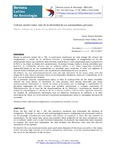Cultura moche como base de la identidad de un nacionalismo peruano

Ver/
A non ser que se indique outra cousa, a licenza do ítem descríbese como Atribución-CompartirIgual 3.0 España
Coleccións
Metadatos
Mostrar o rexistro completo do ítemTítulo
Cultura moche como base de la identidad de un nacionalismo peruanoTítulo(s) alternativo(s)
Moche culture as a base of the identity of a Peruvian nationalismAutor(es)
Data
2017Cita bibliográfica
Revista Latina de Sociología,2017,7(2):17-30.ISSN: 2253-6469
Resumo
[Resumen] Desde la primera mitad del s. XX, el continente americano ha sido testigo del avance del indigenismo. A través de su vertiente cultural y antropológica, el indigenismo se ha ido presentando como una corriente cada vez más consolidada y más capacitada para suplantar en el Perú a los viejos símbolos del nacionalismo. Al mismo tiempo, dada la fuerza simbólica que proyecta la civilización incaica, por su poderío militar y su vasta expansión territorial, inexorablemente se ha ido imponiendo su recuerdo para sustentar el mito que legitima el vínculo entre el Estado peruano y los sentimientos identitarios de sus naciones.Se observa así una instrumentalización cada vez más frecuente de los incas como mito del origen de la alta cultura peruana, tanto en la educación elemental, como en el marketing, en el arte o en la industria del turismo.En el presente artículo analizaremos cómo, si bien la suplantación de los viejos símbolos resultó ser muy eficaz, el resultado de este proceso está siendo discutido por otras construcciones identitarias a través de mitos promovidos por el hallazgo y explotación de ejemplos regionales de alta cultura que pueden remontarse a tiempos anteriores al Tahuantinsuyo. Es el caso de los departamentos de La Libertad y Lambayeque, donde los proyectos arqueológicos en derredor de las culturas moche y chimú están logrando construir un modelo de sustentación identitaria que en distintos escenarios se enfrenta a la idea centralista de elevar las instituciones cusqueñas prehispánicas como el paradigma peruano de su origen. [Abstract] From the first half of the s. XX, the American continent has witnessed the advance of indigenism. Through its cultural and anthropological aspect, indigenism has presented itself as an increasingly consolidated and better able stream to supplant in Peru the old symbols of nationalism. At the same time, given the symbolic force projected by the Inca civilization, due to its military power and its vast territorial extension, its memory has inexorably been imposed to support the myth that legitimizes the link between the Peruvian state and the identity sentiments of its nations.To observe thus an instrumentation more and more frequent of the Incas as myth of the origin of the Peruvian high culture, as much in elementary education, as in the commercialization, in the art or in the industry of the tourism. In the present article we will analyze how, although the impersonation of the results of the brands proved to be very effective, the result of this process is discussed by other identity constructions through myths promoted by the discovery and exploitation of regional examples of high culture that can be traced back to Tahuantinsuyo. This is the case of the departments of La Libertad and Lambayeque, where archaeological projects around the moche and chimeneas cultures are building a model of identity support that in different scenarios is confronted with the centralist idea of elevating pre-Hispanic Cusco institutions as the Peruvian paradigm of its origin.
Palabras chave
Identidad
Indigenismo
Nacionalismo
Moche
Cultura
Identity
Indigenism
Nationalism
Culture
Indigenismo
Nacionalismo
Moche
Cultura
Identity
Indigenism
Nationalism
Culture
Versión do editor
Dereitos
Atribución-CompartirIgual 3.0 España
ISSN
2253-6469






